
©1999-2003. All rights reserved.

|
Adhesives, Puttys and Fillers


ADHESIVES
 PVA
PVA

 This is a water based wood glue. In the US it is known simply as 'white glue'. Some versions are waterproof and
some aren't. It takes quite a while to set and only bonds surfaces well if they are rough and water absorbent such
as wood, paper, card etc. It is also ideal for sticking down sand or flock. It is very cheap compared to most other glues.
This is a water based wood glue. In the US it is known simply as 'white glue'. Some versions are waterproof and
some aren't. It takes quite a while to set and only bonds surfaces well if they are rough and water absorbent such
as wood, paper, card etc. It is also ideal for sticking down sand or flock. It is very cheap compared to most other glues.
Usefulness - Essential
Availability - Very Common
Sources - Model, craft & DIY shops.
 Hot-melt glue gun
Hot-melt glue gun

|
This works by melting sticks of plastic which go in at the back. It
sticks most things very well, although it is a bit messy. It is particularly
good for sticking rubbery plastics such as those used for plastic aquarium
plants, a substance which most other glues are useless for, however
it doesn't perform well with powdery surfaces such as plaster, gritty
surfaces such as sand embedded in PVA, or very smooth surfaces such
as glass.
The glue tends to form stringy lumps which can be used as chemical
spillage or foul alien slime - either leave them clear or inkwash them
for a semi-transluscent colour.
When you buy your glue-gun check whether any glue sticks are included,
they aren't always. The glue-gun costs about £7 and packs of sticks
are about £2.
|
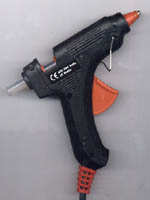
|
Usefulness - Very useful
Availability - Common
Sources - Model, craft & DIY shops.
 Super Glue (cyanoacrylate)
Super Glue (cyanoacrylate)

Super glue will stick almost anything, but is not too good on glossy plastic, very absorbent surfaces and dusty surfaces.
Water makes it set immediately, but dipping it in water to harden it reduces its final strength. It cannot stick large gaps
easily, and any flexing of the joint will break the bond.
Usefulness - Essential
Availability - Very Common
Sources - Model, craft, & DIY shops.
 UHU
UHU

UHU is a good general purpose glue. It can stick across reasonably large gaps, and will stick card faster and stronger
than PVA. Unfortunately it stretches into strings as you use, it so can be messy.
Usefulness - Useful
Availability - Common
Sources - Model, & craft shops.
 Polystyrene Cement
Polystyrene Cement

|
This glue will only glue one type of plastic - polystyrene. Not the white stuff
made of beads, which is expanded polystyrene, but the plastic
that model kits are made of. For this type of plastic it is excellent
as it melts the plastic together, but it will not stick anything else.
It is also available as a liquid rather than the normal tubes which
contain a viscous goo.
The one picture here is 'precision' poly cement, which is fairly runny
stuff dispensed from a long metal nozzle.
|

|
Usefulness - Useful
Availability - Common
Sources - Model shops.
 Epoxy Resin
Epoxy Resin

|
Epoxy resin comes in two tubes which you must mix together to create a compound
which will then harden. It sticks most surfaces and creates a solid
blob that bonds across gaps. Unfortunately, mixing the compound takes
much longer than applying a one part glue.
It is good for sticking the transparent parts in plastic model kits
if you can be neat enough with it. Polystyrene cement or super glue
are solvent based and can produce a white powdery mist on the plastic,
but the epoxy will not.
|
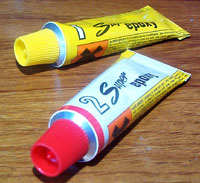
|
Usefulness - Useful
Availability - Common
Sources - DIY, model, & craft shops.
PUTTYS
 Milliput
Milliput

|
Milliput is a two part epoxy putty. Mix the two halves together thoroughly and they will harden over a few hours.
It is not really suitable for very intricate or 'sharply cut' details - click here for some
tips on its use.
Most of the supplies here (15mm biblicals) have been made from Milliput, such as the pots and the haystack.
|
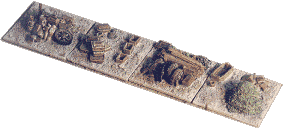
|
Usefulness - Useful
Availability - Common
Sources - Model, craft & DIY shops.
 Green
Putty Green
Putty

|
The first step in producing good models or serious conversions is to get hold of some green putty. This is the stuff
that is actually used by Games Workshop to produce the original of each figure. It is an epoxy putty similar to the widely used
Milliput, however it has very different characteristics when used for modelling. It is much stickier and stretchier than Milliput,
and it also does not have Milliput's unfortunate tendency to crumble when wet. Unfortunately it is far more expensive.
GW sell it under the name 'Kneadatite', but I once bought some from another company under the name 'Duromaster Mend Epoxy Putty'.
Usefulness - Useful
Availability - Rare
Sources - Games Workshop, shops or mail order.
|
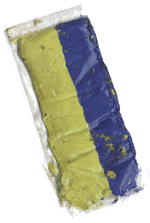
|
 Fimo
Fimo

FIMO is a heat hardened putty. It is crumbly, not very sticky and rather firm for many applications. However, it is cheap. Rather than baking it in the oven, which is a bit of a hassle, I generally just put it under a 100W desk lamp which bakes it nicely in a few minutes. You need to be a bit careful or it can char slightly, also you need to rotate it occasionally to avoid getting soft spots where the putty has not been heated.
Usefulness - Vital for moulding, no other uses
Availability - Rare
Sources - Mail order
FILLERS
 Epoxy Filler
Epoxy Filler

Similar to epoxy resin, this is a two part compound but it is less runny and sticky. Uses for
modelling are pretty limited. The main thing that I have used it for is packing it into silicone
rubber moulds to produce cold cure figures. You tend to get little missing patches, but the crisp edges and surface detail is much better than I got with white metal casting without a centrifuge.
Usefulness - Vaguely Useful
Availability - Fairly Rare
Sources - DIY shops.
 Silicone Rubber
Silicone Rubber

Silicone rubber is used to make moulds for figures, it comes in two pots - the rubber and the
hardener. One problem is that it is very difficult to measure the correct proportions unless you
have some very accurate electronic scales (you put in a very, very small quantity of hardener), and
if you don't put enough in, it will take weeks to set.
It is expensive and hard to obtain. I once mail ordered some RTV430 from TechSil, who make a wide range of
different rubbers. This one is extremely tough and stretchy, so is excellent for moulding. Make sure you get one that can withstand the temperature of white metal.
Usefulness - Vital for moulding, no other uses
Availability - Rare
Sources - Mail order
 Acrylic Medium
Acrylic Medium

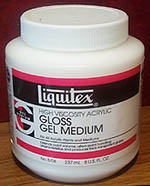 Acrylic
paint consists of powdered coloured pigment and a colourless substance to bind
it together and stick it to the surface This stuff is the colourless medium
on its own. It dries completely clear and very glossy, which makes it good for
creating a water effect as it is easy to get a substantial depth. The only problem
is that it can be difficult to achieve a flat surface. It was used on this oasis. Acrylic
paint consists of powdered coloured pigment and a colourless substance to bind
it together and stick it to the surface This stuff is the colourless medium
on its own. It dries completely clear and very glossy, which makes it good for
creating a water effect as it is easy to get a substantial depth. The only problem
is that it can be difficult to achieve a flat surface. It was used on this oasis.
Usefulness - Water, particularly rippled
Availability - Rare
Sources - Art, craft & model shops
 Casting Plaster
Casting Plaster

Also called 'Plaster of Paris', no idea why. Mix it with water (to get a smooth mix add the plaster to the water,
not the other way round, and use about one part water to 2.5 parts plaster). Make
sure that the container you are mixing in does not have remnants of previous plaster or these will
set the plaster off much quicker. It normally hardens in about five minutes, but will not reach
complete hardness for at least several hours when completely dry.
It is an extremely versatile material. You can use it to make terrain, to
texture walls, to cast small details,
or bigger bits of terrain . The only problem
is that it is somewhat crumbly and easily damaged. A few coats of a tough
paint like Sandtex will help to stop it chipping.
The cost of plaster varies widely. A few pounds sometimes buys a huge sack, but sometimes only
a puny little tub. Try enquiring at an art college, who probably sell large quantities to their
students.
Usefulness - Useful
Availability - Common
Sources - Art, craft & model shops
 Linka Moulds
Linka Moulds

'Linka is a system of reusable, rubber moulds used to make highly detailed brick, stone, and timber buildings and other scenery structures.'
The moulds are 1:72 scale, and make flat panels about 3cm square and 3mm thick (that's 1.5" and 1/8" thick).
Although the scale is 1:72, I often use it for 28mm scenery. You make a few adaptations
such as enlarging the doors, but other than that, it is excellent.
The only drawback is that it's fairly difficult to get panels that are free from bubbles and come out of the
mould unbroken. You will improve with practice, but it's still not easy. All is
not lost, however, as you can use the broken scraps for nifty buildings like this
ruin.
Usefulness - Useful
Availability - Internet
Sources - www.linkaworld.com
 Interior Filler
Interior Filler

This comes as a white powder which is mixed with water to create a paste. It can be used to smooth off terrain and figure bases, plaster the walls of model buildings, make tree trunks etc.
It is stickier, slower drying and tougher than plaster, although it can still be chipped relatively easily. Mixing paint with the water can help to mask these chips, although it will dry a pale colour even with quite a lot of pigment. The most common brand name is 'Polyfilla', but cheaper own brands are available from DIY stores.
Usefulness - Very Useful
Availability - Common
Sources - DIY shops
 Tile Adhesive
Tile Adhesive

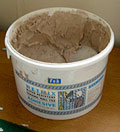 Tile adhesive is my new substitute for filler. It is tougher, so it chips and cracks less easily. It is far
stickier, so you can use it as an adhesive. Finally it comes in a big tub already mixed so it's really convenient, and I had loads
left over from doing some tiling. Perfect. It takes slightly longer to set than filler (and slightly longer than
plaster, but the wait is worth it).
Tile adhesive is my new substitute for filler. It is tougher, so it chips and cracks less easily. It is far
stickier, so you can use it as an adhesive. Finally it comes in a big tub already mixed so it's really convenient, and I had loads
left over from doing some tiling. Perfect. It takes slightly longer to set than filler (and slightly longer than
plaster, but the wait is worth it).
Usefulness - Very Useful
Availability - Common
Sources - DIY shops
|